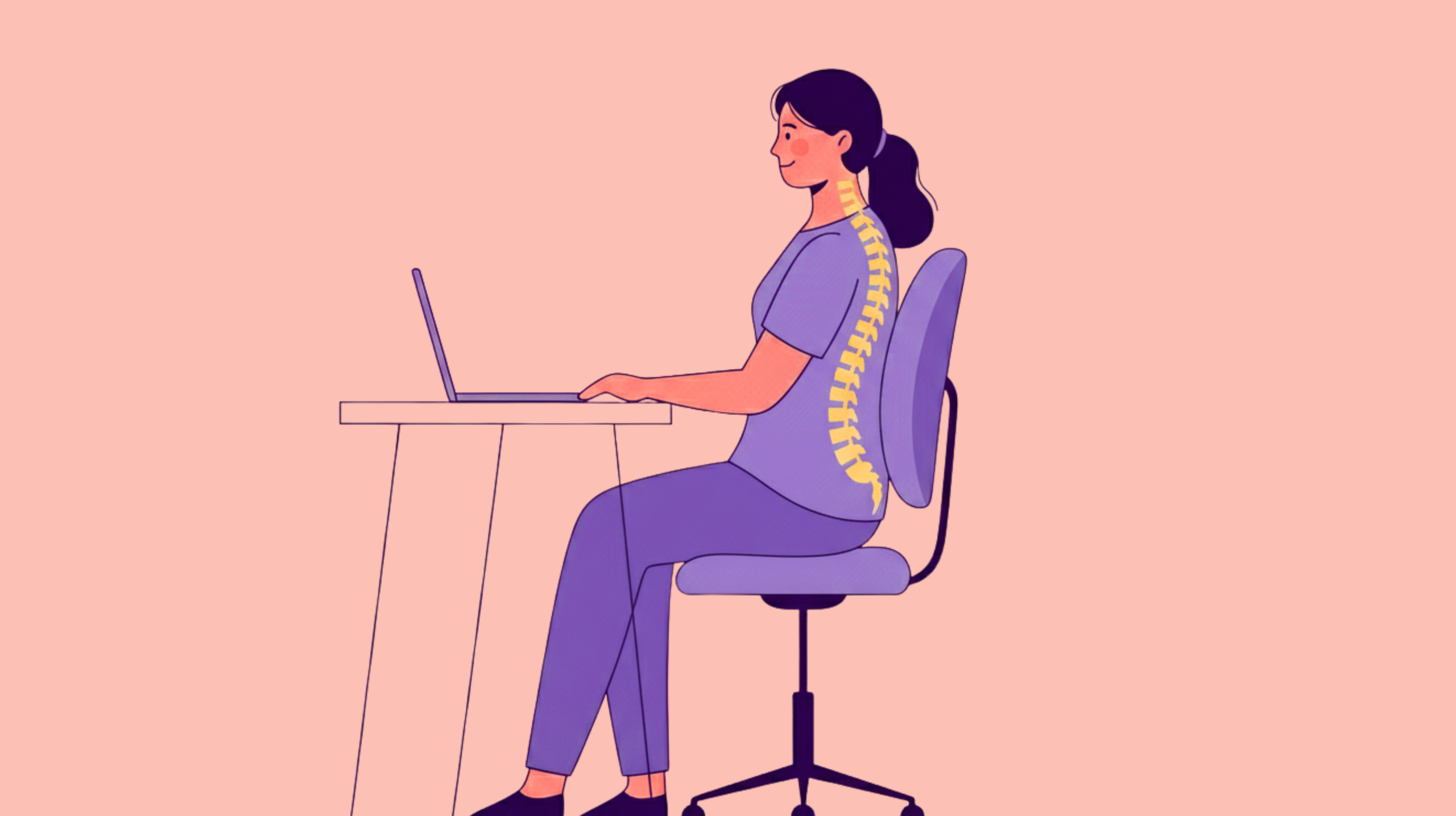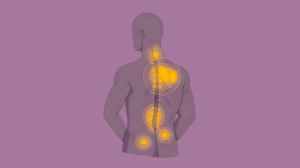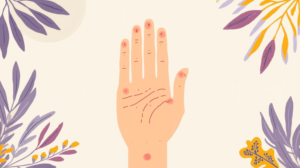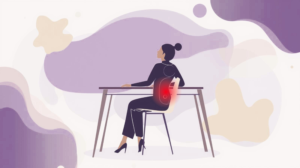Importance of Posture and Spinal Health
The spine is the main support structure that is covered by the spinal cord. The spine provides balance to the body as well as enables movement. Individuals that spend a lot of hours sitting, using electronic devices, or not moving around, significantly tend to experience bad posture. Low back pain is among the primary causes that make human beings unable to work or live a good life. It impacts millions of adults and reduces their productivity [1].
To avoid chronic musculoskeletal issues, it is necessary to take care of your spine and balance. To prevent neck and back pain, ergonomics desks, chairs, and other supporting equipment can be used.
Back Rest as a Solution
When seated, the natural curve of the spine should be supported by a backrest. The use of back rests helps to maintain better posture, reduce the risk of musculoskeletal stress, and gives a comfortable sitting experience when sitting for prolonged periods. Besides making your spinal alignment better, they also treat back pain and other back related issues.
Modern back rests have evolved through the years to fulfill various physical requirements, starting with relatively simple cushioning to orthopedic cushions that can be adjusted to suit natural spinal contour. A good back rest is regarded by many people as a cheap and long-term measure to support the spine.
Understanding Back Rest
What Is a Back Rest?
A back rest is a supportive device designed to stabilize and support the spine while sitting or reclining. It can be integrated into furniture, such as office chairs and beds, or exist as portable cushions for travel. The primary function is to maintain proper spinal alignment, distribute pressure evenly, and minimize fatigue during prolonged sitting or lying down.
Back rests are particularly beneficial for the lumbar region, which bears significant load and is prone to injury. Many designs focus on lumbar support to prevent slouching and reduce compressive forces on the vertebrae and intervertebral discs.
Types of Back Rests
- Ergonomic Chair Back Rests:
Built into office or home chairs to promote correct posture and reduce fatigue during long hours of sitting. - Lumbar Support Cushions:
Portable cushions placed on existing chairs, often made of memory foam or orthopedic materials to support the lower back. - Travel and Car Back Rests:
Compact, lightweight supports designed for use in vehicles or during flights to prevent back strain during long journeys. - Adjustable Bed Back Rests:
Used in beds or recliners, these allow individuals to adjust the angle for reading, working, or relaxation while maintaining proper spinal alignment.
Common Materials Used
- Memory Foam: Conforms to the shape of the spine for personalized support.
- Mesh: Provides breathability and lightweight support in office chairs.
- Orthopedic-Grade Cushions: Firm materials designed to provide medical-grade lumbar support.
- Gel or Hybrid Foam: Adds cooling comfort while maintaining structural support.
Health Benefits of Using Back Rests
Posture Correction
Using a back rest encourages proper spinal alignment, reducing slouching and forward hunching. Maintaining correct posture not only relieves immediate discomfort but also prevents long-term spinal deformities such as kyphosis or lordosis [2]. Proper alignment improves core muscle engagement, supporting the back naturally and reducing dependence on external devices over time.
Pain Reduction
Back rests can significantly reduce lower back pain and stiffness, especially in individuals with prolonged sedentary habits or spinal issues such as herniated discs or sciatica. By distributing weight evenly, back rests relieve pressure on vertebrae and intervertebral discs, reducing inflammation and discomfort.
Comfort and Relaxation
Back rests provide long-term comfort during work, study, or leisure. They reduce muscle fatigue, allowing for longer periods of sitting without pain, and support the back during rest, reading, or watching TV.
Prevention of Long-Term Damage
Regular use of ergonomic back rests reduces the risk of chronic spinal injuries, repetitive strain injuries, and postural deformities [3]. Office workers and drivers, in particular, benefit from back supports that prevent cumulative musculoskeletal strain.
Uses of Back Rests in Different Settings
Office Chairs
Office workers often spend 6-8 hours a day sitting at desks. A back rest reduces fatigue, supports lumbar curvature, and promotes productivity by minimizing discomfort and distractions. Ergonomic chair back rests can be height-adjustable or contoured to fit different spine shapes.
Car Seats
Long drives and daily commuting can lead to back pain due to prolonged sitting and vibration. Car back rests improve comfort, maintain spinal alignment, and prevent fatigue or injury during extended journeys.
Home and Study Chairs
Back rests for study or home chairs assist children and adults in maintaining proper posture while reading, writing, or using computers. This is especially important for school-aged children to prevent early onset of spinal strain.
Beds and Relaxation Spaces
Adjustable back rests in beds or recliners allow comfortable support while watching TV, reading, or resting. They are particularly helpful for elderly individuals with limited mobility or chronic back pain.
Travel and Portable Options
Portable back rest pillows are designed for airplanes, buses, or trains. They are lightweight, compact, and can be carried easily, providing ergonomic support on-the-go.

Types of Back Rests and Their Special Features
Lumbar Support Back Rests
Target the lower back to relieve pressure on the lumbar spine. Commonly used in office chairs and vehicles.
Orthopedic Back Rests
Medical-grade supports designed for patients with spinal issues or chronic back pain. They provide firm support and promote spinal alignment [4].
Memory Foam Back Rests
Conform to individual body shapes, offering personalized comfort and pressure relief. Reduce localized stress and improve posture.
Adjustable and Portable Back Rests
Allow customization for different angles, heights, and firmness levels. Ideal for travel or multi-use environments.
Choosing the Right Back Rest
Selecting an appropriate back rest is crucial to ensure effective support, comfort, and long-term spinal health. The right choice depends on ergonomics, durability, user needs, and the environment in which it will be used.
Factors to Consider
- Ergonomic Design:
Look for back rests that support the natural curvature of the spine, especially the lumbar region. Contoured designs reduce slouching and provide consistent support. - Adjustability:
Height, angle, and firmness adjustments allow users to customize support for their body type and activity, whether sitting at a desk, driving, or reclining. - Material Quality:
Memory foam and orthopedic-grade cushions offer durability, pressure relief, and comfort. Breathable materials such as mesh prevent overheating during prolonged use. - Compatibility:
Ensure the back rest fits the chair, car seat, or bed where it will be used. Some portable supports are universal, while others require specific dimensions. - Maintenance and Cleaning:
Removable covers and washable materials are ideal for hygiene, especially in high-use settings.
Recommendations for Different Users
- Office Workers: Ergonomic chair back rests with adjustable lumbar support are ideal to reduce fatigue during prolonged desk work.
- Drivers: Car back rests or lumbar cushions prevent lower back strain on long drives.
- Students: Lightweight portable back rests help maintain posture during study sessions.
- Elderly Individuals: Adjustable bed back rests or recliner cushions provide comfort and spinal support, reducing the risk of falls or stiffness.
- Travelers: Compact, portable back rest pillows offer ergonomic support for flights or bus journeys.
Cost vs. Health Benefits
While high-quality back rests may require a larger initial investment, they offer long-term benefits by preventing back pain, improving posture, and reducing the risk of musculoskeletal disorders. Investing in proper spinal support can reduce work-related back pain significantly and enhance productivity [5].
Lifestyle and Ergonomic Practices Along with Back Rest Use
Using a back rest alone is beneficial, but combining it with healthy habits and ergonomic practices maximizes spinal health and comfort.
Combining Back Rests with Healthy Habits
- Regular Breaks: Stand up, stretch, and walk every 45–60 minutes to prevent stiffness and improve circulation.
- Correct Sitting Posture: Keep feet flat on the floor, knees at 90 degrees, and spine aligned with the back rest.
- Workstation Ergonomics: Adjust desk height, monitor position, and chair placement to minimize strain.
Role of Exercise and Strengthening
- Core Exercises: Strengthen abdominal and lower back muscles to provide natural spinal support.
- Back Strengthening: Activities like yoga, pilates, or targeted physiotherapy help maintain alignment and reduce reliance on external supports.
- Flexibility Training: Stretching the hamstrings, hip flexors, and lower back reduces tension and improves posture.
Creating an Ergonomic Environment
- Desk Setup: Place monitor at eye level and keyboard at a comfortable height to avoid slouching.
- Supportive Furniture: Use chairs with adjustable height, lumbar support, and armrests to maintain proper alignment.
- Lighting and Eye Level: Proper lighting reduces neck strain, which indirectly affects back posture.
Research Insight: Studies show that combining ergonomic back rests with exercise and correct workstation setup significantly reduces musculoskeletal discomfort, prevents chronic back pain, and improves work efficiency [6].
When to Seek Medical Advice?
While back rests and ergonomic practices help most individuals, persistent or severe back issues may require professional evaluation. Early intervention can prevent complications and improve long-term spinal health.
Signs of Serious Back Problems
- Persistent Pain: Pain that lasts several weeks despite using a back rest and ergonomic adjustments.
- Numbness or Tingling: Especially in the legs or feet, which may indicate nerve compression.
- Muscle Weakness: Difficulty lifting, walking, or maintaining balance.
- Limited Mobility: Inability to bend, twist, or stand comfortably.
- Swelling or Redness: Could signal infection or inflammation in the spinal region.
If any of these symptoms occur, consult a healthcare provider promptly.
Role of Professional Guidance
- Physiotherapists: Assess posture, strength, and flexibility, providing personalized exercises and back rest recommendations.
- Orthopedic Doctors: Diagnose structural issues like herniated discs, spinal stenosis, or scoliosis that may require specialized interventions.
- Occupational Health Experts: Offer ergonomic assessments for workplaces to prevent chronic back strain.
Medical guidance ensures that back rest use complements treatment rather than masking serious conditions.
Conclusion
Back rests are essential in a variety of settings, including homes, offices, automobiles. Maintaining proper health of the spine helps in improving posture, and reducing the pain. These prevent the development of musculoskeletal issues in the long-term and give you better comfort during prolonged sitting or rest. Having a comfortable backrest is not an unnecessary option, but also a precaution towards an overall healthy back and, eventually, an improved life.
Back and neck pain are often connected. So, if neck pain is also bothering your routine life, check these out:
Frequently Asked Questions:
1. What are the main uses of a backrest?
Supports the spine, improves posture, reduces back pain, and enhances comfort during sitting or resting.
2. How does a back rest improve posture?
By encouraging the natural curvature of the spine and preventing slouching, it maintains alignment of the lumbar and thoracic regions.
3. Can a back rest reduce back pain?
Yes, especially lower back pain, sciatica discomfort, and stiffness from prolonged sitting.
4. Is a lumbar support cushion the same as a back rest?
Not exactly. A lumbar cushion primarily supports the lower back, while a full back rest can support the entire back, including thoracic and cervical regions.
5. What type of back rest is best for office chairs?
Ergonomic chair back rests with adjustable lumbar support, height, and firmness are ideal for prolonged desk work.
References
- WHO (2023). Low back pain. Retrieved from: https://www.who.int/news-room/fact-sheets/detail/low-back-pain [Viewed on 29 October 2025]
- Du, S. H., Zhang, Y. H., Yang, Q. H., Wang, Y. C., Fang, Y., & Wang, X. Q. (2023). Spinal posture assessment and low back pain. EFORT open reviews, 8(9), 708-718. DOI: https://doi.org/10.1530/EOR-23-0025
- Pope, M. H., Goh, K. L., & Magnusson, M. L. (2002). Spine ergonomics. Annual review of biomedical engineering, 4(1), 49-68. https://doi.org/10.1146/annurev.bioeng.4.092101.122107
- Cerillo, J. L., Becsey, A. N., Sanghadia, C. P., Root, K. T., & Lucke-Wold, B. (2023). Spine bracing: when to utilize—a narrative review. Biomechanics, 3(1), 136-154. https://doi.org/10.3390/biomechanics3010013
- Frank, J., Sinclair, S., Hogg-Johnson, S., Shannon, H., Bombardier, C., Beaton, D., & Cole, D. (1998). Preventing disability from work-related low-back pain. New evidence gives new hope–if we can just get all the players onside. Cmaj, 158(12), 1625-1631. https://www.cmaj.ca/content/158/12/1625.short
- Shariat, A., Cleland, J. A., Danaee, M., Kargarfard, M., Sangelaji, B., & Tamrin, S. B. M. (2018). Effects of stretching exercise training and ergonomic modifications on musculoskeletal discomforts of office workers: a randomized controlled trial. Brazilian journal of physical therapy, 22(2), 144-153. https://doi.org/10.1016/j.bjpt.2017.09.003























